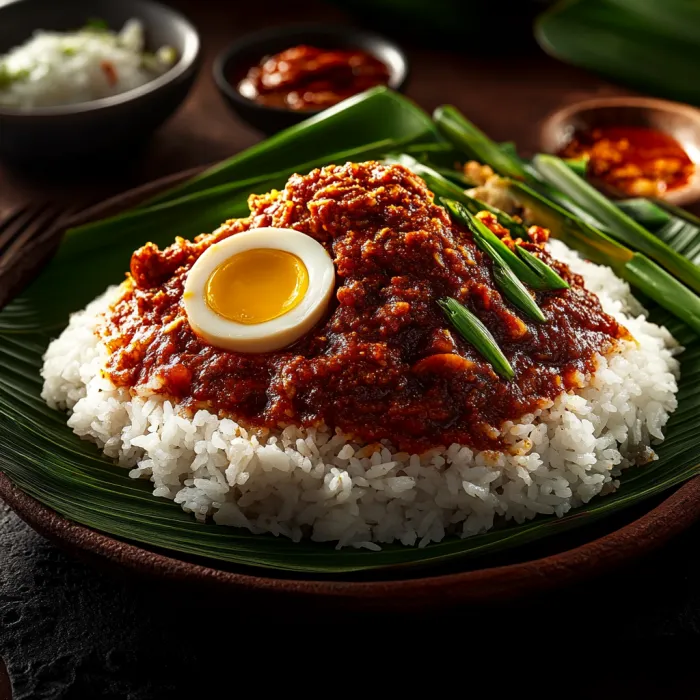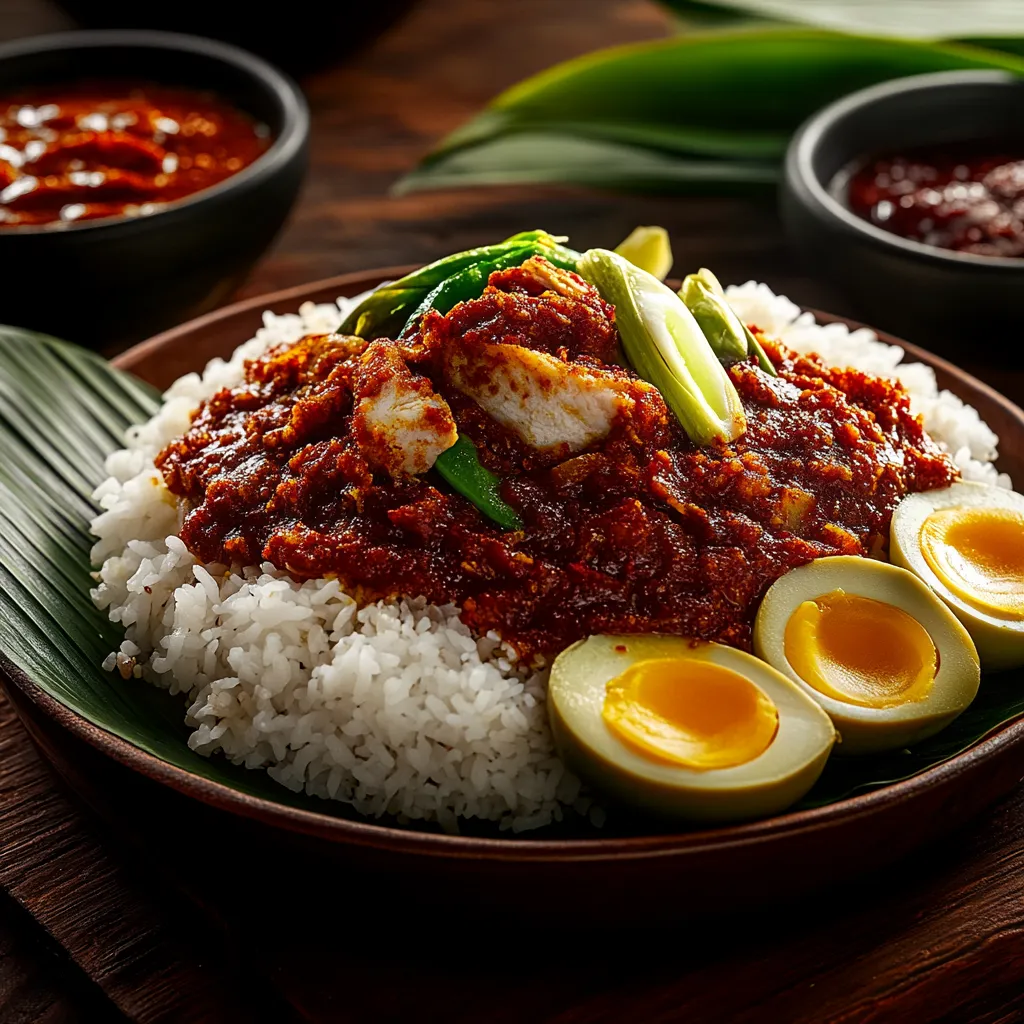 Save
Save
Nasi lemak brings together creamy coconut rice, spicy sambal, crunchy anchovies, and all the traditional goodies that make breakfast special in Malaysia. This dish is perfect when you crave comfort food that feels both memorable and festive, whether for a Saturday brunch or a taste of home.
The first time I made nasi lemak, the aroma of pandan and coconut immediately transported me back to my childhood kitchen. Now it is a tradition for family birthdays and lazy Sundays.
Ingredients
- Jasmine rice or pandan rice: produces fluffy grains that best soak up coconut
- Coconut milk: thick and good quality is key to aroma
- Water: balances out the coconut milk for perfect texture
- Pandan leaf: tied in a knot is traditional and fragrant fresh leaves can be found in many Asian shops
- Salt: highlights the sweet creaminess of rice
- Ginger: adds a warm background note
- Dried red chilies and fresh red chilies: together create depth and bite in sambal
- Red onions: for sambal bring subtle sweetness
- Garlic: makes sambal savory
- Belacan: fermented shrimp paste boosts umami toast it for best flavor
- Tamarind paste: balances the heat with tang
- Sugar: palm sugar adds caramel notes to sambal
- Vegetable oil: is best for frying the sambal paste
- Dried ikan bilis: pick small silvery ones that fry super crisp
- Eggs: use fresh for best soft-boiled texture
- Cucumber: adds juicy freshness
- Roasted peanuts: for crunch and richness look for unsalted
- Banana leaf (optional): but highly authentic and aromatic
Step-by-Step Instructions
- Rinse the Rice:
- Wash jasmine or pandan rice in several changes of water until it runs almost clear. This step prevents sticky rice and is worth doing well.
- Cook the Coconut Rice:
- In a rice cooker or heavy pot, combine the rinsed rice, thick coconut milk, water, salt, ginger slice, and a knotted pandan leaf. Turn on the rice cooker or bring the pot to a boil, lower heat, and cook until rice is tender, fluffy, and all liquids are absorbed. Let it rest covered for 10 minutes before gently fluffing.
- Blend and Fry Sambal Paste:
- Soak dried red chilies in hot water until soft. Remove seeds if you want less heat. Blend with fresh chilies, onions, garlic, and toasted belacan into a smooth paste. Heat oil in a deep pan over medium heat. Add paste and fry, stirring often, for about 10 to 15 minutes until deeply fragrant and oil begins to separate.
- Season the Sambal:
- Add tamarind paste, palm sugar, and salt. Simmer another 5 minutes to meld the flavors before setting aside.
- Fry Crispy Anchovies:
- Rinse dried ikan bilis in cold water and pat them fully dry with paper towels. Heat enough oil for shallow frying in a pan. Add anchovies and fry on moderate heat, stirring, until they are crunchy and bronzed. Lift out and drain on paper towels.
- Prepare Optional Accompaniments:
- Slice cucumber thin for a juicy counterpoint. Roast peanuts until warm if not already ready. Prepare banana leaf if using.
- Make Soft-Boiled Eggs:
- Bring water to a strong simmer in a saucepan. Carefully lower in eggs and cook for 6 to 7 minutes for soft set yolks. Plunge in cold water, peel, then halve.
- Assemble the Plate:
- On a serving plate lined with banana leaf, pile up a mound of coconut rice in the center. Spoon sambal over or beside it. Add half a soft-boiled egg. Place a handful of crispy anchovies, cucumber slices, and peanuts around. Garnish with fresh herbs or extra chili if you like.
 Save
Save
My top ingredient here is pandan leaf. Every time I tie it in a knot and inhale the scent, I think of my grandmother teaching me in her sunlit kitchen. Family laughs and the sizzle of anchovies always crowd my mind on nasi lemak mornings.
Storage Tips
Coconut rice keeps well in the fridge for three days and sambal can be stored in an airtight jar for up to a week. Reheat rice with a little splash of hot water to restore fluffiness before serving leftovers.
Ingredient Substitutions
If you cannot find pandan leaves, skip them and use a few drops of vanilla essence for a subtle fragrance. Belacan can be left out for a vegetarian sambal or replaced with a touch of fish sauce for umami.
Serving Suggestions
Serve nasi lemak with extra sambal on the side for those who like it spicy. Pair with fried chicken or Malaysian-style curry for a bigger meal. It is delicious packed into a banana leaf and eaten picnic style.
Cultural Context
Nasi lemak is the pride of Malaysian breakfasts and symbolizes the coming together of diverse cultures. It is found everywhere from street stalls to festive family tables. Preparing it at home connects you with rich traditions and timeless flavors.
Recipe FAQs
- → What type of rice should I use?
Jasmine or pandan rice work best, giving a fluffy and fragrant base when cooked with coconut milk and pandan leaf.
- → How spicy is the sambal?
Heat level can be adjusted by using fewer chilies or deseeding them before blending. Sambal is typically spicy but customizable.
- → Can I substitute anchovies?
While crispy dried anchovies (ikan bilis) are traditional, you can use small dried fish or omit for a vegetarian option.
- → What are must-have garnishes?
Soft or hard-boiled eggs, sliced cucumber, roasted peanuts, and fresh herbs all complete the authentic experience.
- → Do I need a banana leaf for serving?
Banana leaves add aroma and a rustic touch, but it's optional. Plates alone are perfectly fine for serving.
- → How should leftovers be stored?
Keep components separate in airtight containers in the refrigerator. Reheat rice and sambal before serving again.
